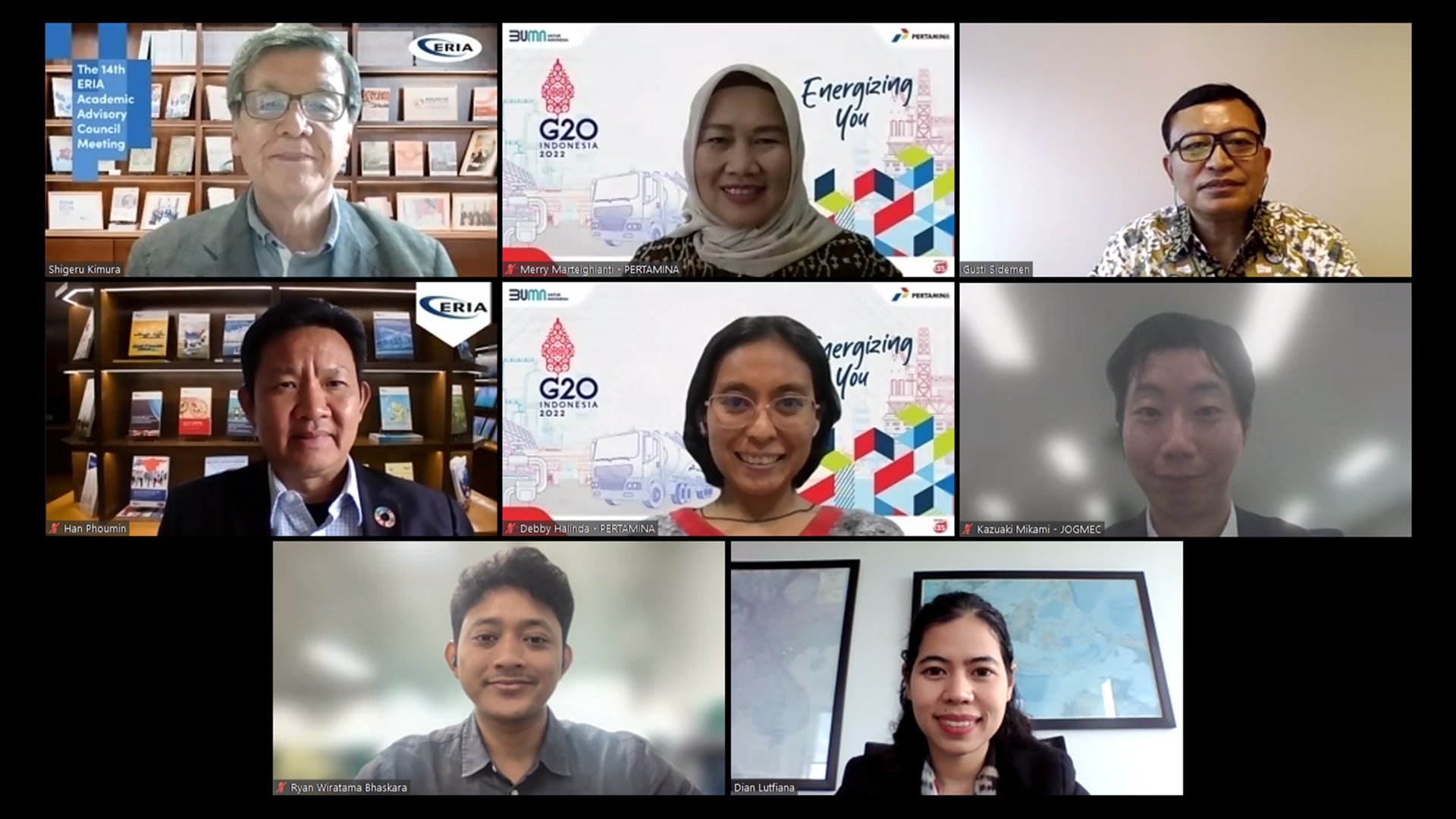Pertamina and JOGMEC Give In-Depth Look at Huff and Puff EOR Project to Promote Decarbonisation Tech in Asia
The 8th Knowledge Sharing Virtual Conference, 13 April 2023: Pertamina and the Japan Organisation for Metal and Energy Security (JOGMEC) presented the initial findings of their latest project on huff and puff carbon dioxide (CO2) enhanced oil recovery (EOR) in the Jatibarang field in Indonesia. This pioneering work aims to promote Carbon Capture and Storage (CCS) and Carbon Capture and Storage (CCUS) technologies in Southeast Asia amid increased efforts to achieve net-zero emissions. The primary objective of the project is to acquire data that would facilitate a future pilot study. The initial project results were presented during the 8th ACN Knowledge Sharing Conference on 13 April 2023. The event was hosted by the Economic Research Institute for ASEAN and East Asia (ERIA) which serves as the secretariat of the Asia CCUS Network (ACN).
Mr Shigeru Kimura, Special Advisor to the President on Energy Affairs, ERIA delivered the Opening Remarks by underscoring the benefits of CO2 EOR for Southeast Asia as it is a lower-cost solution that can increase oil production. Thus, this technology is an ideal starting point to further promote CCS in the region. Event moderator, Mr I Gusti Suarnaya Sidemen, Expert on CCS/CCUS, ERIA stipulated that the 8th ACN Knowledge Sharing Conference was crucial ‘to promote collaboration and cooperation on the deployment of CCS/CCUS and accelerate decarbonisation in the Asian region.’ He further explained that the huff and puff method has existed since the 1960s, however, it has seen slow development due ‘to the availability of easier and cheaper ways to produce resources.’ As most oil fields in Asia are mostly depleted, there is an ongoing revival of this technology hence making the conference timely and relevant.
The first speaker of the Presentation Session was Ms Merry Marteighianti, VP Upstream Research and Tech Innovation, Pertamina who gave an overview of the motivation and objectives behind the Jatibarang field project, Indonesia’s regulatory framework concerning huff and puff as well as the results. Pertamina remains committed to reaching its net-zero commitments and has pushed for the promotion of CCS/CCUS technology by facilitating projects such as huff and puff CO2 EOR.
Jatibarang field is in West Java and was first discovered in 1968 during which Pertamina built several wells throughout the years. Based on data from November 2022, the current production of the field is approximately 8,865 barrels of oil per day (BOPD). Ms Marteighianti stipulated that plans to conduct CO2 EOR in the field began in 2019, but the huff and puff process only took place in October 2022 on two wells; Pertamina is planning a pilot project for the CO2 EOR and aims for a full-scale EOR in 2031. There are two primary objectives behind their huff and puff CO2 injection, namely: 1. To incorporate CO2 to boost petroleum recovery in the Jatibarang field while upholding Pertamina’s decarbonisation target; and 2. To validate the performance and response of the wells and reservoirs following a CO2 injection which will serve as an input in the development of field-scale EOR projects.
Pertamina equipped the Jatibarang field with carbon steel tubing to carry out its project in which there are three stages to the huff and puff process: Injection (‘huff’), Soaking (‘soak’), and Production (‘puff’). The huff stage required 2.5 days before the soaking process took place and it is then closed for one to two weeks. After two weeks, oil production commences which is monitored and produced for up to three months. Project engineers cannot determine an optimum soaking period for the Jatibarang field as they require more trial and error to optimise this particular step hence, as a reference, the soaking time is set at one to two weeks. The CO2 source is from Pertamina’s Subang field which is about 100 kilometres from Jatibarang, thus trucks are deployed to transport the CO2 between the two locations.
Following two well injections, Pertamina reported significant achievements including a 370% increase in the production rate for well JTB-137 where production grew from 10 BOPD to 47 BOPD, water cut decreased by 30%, and 218 tonnes of CO2 was used. For well JTB-161, the production rate rose by 227% from 22 BOPD to 72 BOPD, the water cut decreased by 23%, and 250 tonnes of CO2 was used. The project results additionally showed that the utilisation factor of JTB-161 reached 5.1 standard cubic feet per stock tank barrel (MSCF/STB) and JTB-137 reached 10 MSCF/STB. Ms Marteighianti ended her presentation by underscoring the importance of international cooperation for knowledge sharing, expertise, and funding purposes to spur necessary technological advancements that can reduce capital and operational expenditures.
The second speaker, Ms Deby Halinda, Expert Research and Tech Innovation, Pertamina, gave a more technical glimpse of Pertamina’s case study. The decision to undergo the huff and puff process was mainly to obtain ‘CO2 reservoir injectivity data as well as to assess the effect of CO2 injection into the Jatibarang oil reservoir in terms of changes to the physical properties, composition of oil, water, and gas through lab tests and visual observations.’ Acquiring data and information is an essential part of the technical evaluation step as the company targets a field-scale implementation plan. Pertamina additionally wanted to assess if oil recovery or gain would occur and if there would be any corrosion in the well equipment as well as surface production facilities during the process.
Ms Halinda shared lessons based on her team’s experience on the project. From a subsurface standpoint, Ms Halinda stated that huff and puff will require further study ‘which would be the pilot CO2 injection’ and would involve two wells that are then flooded to assess whether there is an interference between the wells. An in-depth geochemistry study will be necessary to further investigate CO2 effects on reservoir rock and fluids ‘which includes the scale occurrence, CO2 solubility in water, and asphaltenes test.’ She added, ‘We must study and evaluate it before we do the CO2 flooding.’ From an operational perspective, Ms Halinda asserted that well integrity and pre-work are mandatory in addition to a pre-inspection check of pumping equipment. ‘Lastly, we need to have a clear arrangement so we can continue a continuous operation,’ she concluded.
Mr Kazuaki Mikami, Reservoir Engineer and Deputy Director of Sub-Surface Division Hydrogen and CCUS Department, JOGMEC gave a comprehensive background behind the huff and puff method during the Commentary Session based on his expertise as a member of the Jatibarang project. Mr Mikami explained how CO2 EOR is more complex than pure CCUS given that, from a reservoir engineering point of view, ‘we need to consider CO2, oil, and water, including the interaction between CO2 and oil.’ He stressed that huff and puff is not a new technology and that it is proven and effective for emissions reduction. The cost-effectiveness of this method is particularly crucial considering the difficulties of proceeding with a pilot project due to investment constraints. ‘I think CO2 huff and puff is a good starting point for implementing CO2 EOR,’ Mr Mikami shared.
There are several considerations to make before implementing huff and puff and these include lab experiments, good reservoir characterisations, careful design for production, monitoring, and having quality data. ‘Depending on wells features and wells productivity and artificial lifting, we need to optimise monitoring strategy including monitoring frequency and also the analysis. This is also an important point for CO2 EOR as CCS/CCUS since we need to monitor CO2 flow in the system accurately from a CCS/CCUS perspective,’ he explained. Mr Mikami additionally informed the audience of JOGMEC’s plans to conduct a similar huff and puff procedure in Japan this year which he looks forward to sharing the experience with the ACN network.
During the Question and Answer Session, the three guest speakers took turns answering the audience’s questions on topics ranging from regional project plans to technical and operational details. On Pertamina’s plan for another huff and puff CO2 EOR project in the region, Ms Marteighianti stipulated that the company has several plans in the pipeline including one for the Sukowati field. The insights gained from the Jatibarang field ‘will help us optimise the method that we can use when we do a full-field scale for the implementation. In the near future, we will have another huff and puff as we see that it is beneficial and important and it will still be in Java Island,’ she shared. Regarding the regulatory and legal framework of CO2 EOR, Ms Marteighianti clarified that it can be implemented as the regulation is already in place. She explained that discussions around CCS/CCUS are often linked to carbon trading which the current regulation does not cover.
The topic of CO2 leakage was frequently raised during the session, however, Ms Halinda stated that the project did not have a leakage. Instead, it had a high concentration of CO2 for 2.5 days during the huffing stage. Ms Halinda further added that based on their production monitoring of both wells, over 70% of the 200 tonnes of CO2 injected is assumed to remain in the reservoir while approximately 30% resurfaced. Mr Mikami answered the question on the possibility of applying CO2 EOR in the same well or field which he stated that it is possible, however, for the Jatibarang field project, the primary objective is to acquire data on-site. ‘We implemented the CO2 huff and puff for pilot purposes and data acquisition,’ he reiterated.
Dr Han Phoumin, Senior Energy Economist, ERIA gave the Closing Remarks by highlighting the benefits of the huff and puff method and the importance of collaboration to meet the net-zero emissions target. Pertamina and JOGMEC’s case study demonstrates how crucial government and institutional support, corporate commitment, and international collaboration are to facilitate huff and puff projects. Dr Phoumin underscored the advantages of a good partnership for sharing project costs and risks in addition to acquiring the right technology and capabilities to pursue huff and puff endeavours. Pertamina and JOGMEC’s accomplishments on the Jatibarang CO2 EOR project illustrate the significance of knowledge sharing and partnership in advancing the research and potential of CCS/CCUS technologies in Asia.

